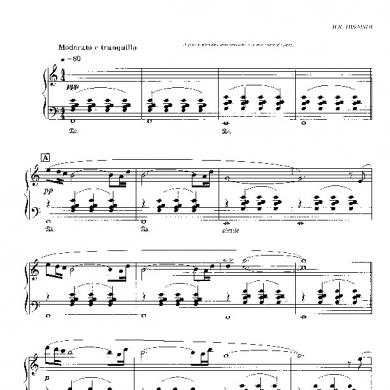Review Of Wearable Treasures: Jewelry And Ornaments Of The Maghreb
This document was uploaded by user and they confirmed that they have the permission to share it. If you are author or own the copyright of this book, please report to us by using this DMCA report form. Report DMCA
Overview
Download & View Review Of Wearable Treasures: Jewelry And Ornaments Of The Maghreb as PDF for free.
More details
- Words: 1,569
- Pages: 12
Loading documents preview...
Bijoux et parures du Maghreb: des trésors à porter (Wearable Treasures: Maghreb Jewelry and Ornaments) l'Institut du Monde Arabe (Institute of the Arab World) 1 rue des Fossés-Saint-Bernard Paris 5e February 11th - August 28th 2016 Published at Hyperallergic as The Pulsing Patterns of Traditional North African Jewelry http://hyperallergic.com/318418/the-pulsing-patterns-of-traditional-north-african-jewelry/
Aït Atta Tribe, Morocco, “Bracelets” (XIXe siècle) silver
Maghreb Jewelry and Ornaments is a pointed consideration of the psychic powers interlaced throughout North African women’s ornamental jewelry. The variety of forms and designs that the jewelry utilizes in creating rich streams of visual inflection requires acute attention - reflecting as they do, the diversity of peoples and identities of the regions that constitute the Maghreb. The oscillating visual language of Maghreb jewelry usually hovers between abstract geometry and modes of repetitive graphic presentation, done with such all-over delicate precision that in may rise to the province of luxurious value. Its function as magical symbol often stems from this allover many-in-oneness unity. Even as the jewelry can also mark off social boundaries.
The diverse powers of the many regional styles on display here raises the issue of the craftsmanship of ornamental jewelry out of the opinion that it is merely producing superficial decoration, into an arena of engaging with cultural spiritual forces that surpass (while using) beautification in the interests of organic need. For millennia, North Africa, including the nations of Algeria, Tunisia, Morocco, Libya and Egypt, served as a crossroads for the Middle East sub-Saharan Africa and Europe. Starting well before the Christian era, Phoenicians, Egyptians, Romans and Greeks mingled with the Amazigh people (also known as Berbers - thought to be the original inhabitants of the region along with Africans from south of the Sahara Desert). Following the Arab conquest of North Africa in the 7th century, the Berbers gradually converted to Islam and over generations assimilated into Arab communities.
Morocco, “Khamsat (mains) ciselées motifs” (XXe siècle) Argent ciselé, H.11-18; l.6-11 cm Collection Bouvier © Marc Bouvier
Aurès, Algeria, “Collier Khamsat” (XXe siècle)
The ornamental designs engraved into Maghreb jewelry often suggests the environment of nature, suggesting interwoven flowers, vines, animal tracks, the lapping of sea waves, or the rippling of fields of grain. The feeling of interlacing movement dominates. And this makes sense, as the rich mixture of designs and materials used in the jewelry of Morocco, Algeria and Tunisia reflects the varied cultures of the region’s inhabitants and their extensive history of movement and trade. In North Africa, a woman’s jewelry, such as the Moroccan “Khamsat (mains) ciselées motifs” Hamsas (silver hands of Fatima) and the “Collier Khamsat” from Aurès, Algeria, have symbolic magical meanings extraneous to their ornamental function, and they are used as enchanted charms and talismans to protect against evil eyes. Also head ornaments, earrings, necklaces, brooches, bracelets and anklets possess functions at once magico-utilitarian and seductive-decorative. Most Maghreb jewelry, by suggestively emulating nature’s cycles and rhythmic movement, propounds something of the repetitious cadence observed in our own intertwining movements when we
engage in the pleasurable activities of music, dance and libidinousness. Of course, adornments also add resplendence, desirability, and opulence to a woman’s appearance. Women receive jewelry when they marry and wear them as symbolic expressions of their wedded identity, but regardless of what social code is expressed, the pieces’ significant symbolic essence is also part and parcel with the lavish amount of time and patience encoded into each object, as we see in the complex geometric-formed multicolored piece from Grande Kabylie, Algeria, “Collier orné d’une boîte à talisman herz” (XXe siècle). Its ornamental splendor charms the eye and also fulfills a beneficial metaphysical purpose by suggesting a dangling sense of continuance free from pressing urgency. This through the use of cloisonné enameling and hanging beads. Of Turkish and Central Asian origins, cloisonné is a technique Jewish silversmiths (descendants of the Jews who fled Spanish persecution beginning in the 13th century) specialized in. Other techniques, such as filigree granulation and engraving suggest ties to areas as distant as Yemen, Syria and Somalia. Here forms may enmesh and contradict, altering and disrupting the mundane in an inexorable and chimerical way.
Grande Kabylie, Algeria, “Collier orné d’une boîte à talisman herz” (XXe siècle) Argent émaillé et corail Collection Bouvier © Marc Bouvier In the flamboyant, delicate and intricate silver and gold elaborate jewelry worn by North African women, pendants made of colored enamels and precious or semiprecious stones are conspicuous. Streams of beads in all shapes and sizes are sometimes used, made of stone, coral, amber, glass, shell and even old coins, as we see in the sumptuous neckless “Collier tlila orné de perles baroques, pendentifs en argent doré” (XXe siècle) from Moknine in the Monastir Governorate area of Tunisia. The coins, frequently used in the production of Tunisian jewels, are believed to have the property of repelling the evil eye.
Moknine, Tunisia, “Collier tlila orné de perles baroques, pendentifs en argent doré” (XXe siècle) Argent doré et perles, L.23; l.14 cm Collection Bouvier © Marc Bouvier
Moknine, Tunisia, “Paire de fibules (khella) ornées de rinceaus et d’une khamsa – Or moulé et ciselé” (XXe siècle) Collection Bouvier © Marc Bouvier
Much Maghreb jewelry seems to embody the human inclination towards repetition and reiteration. Some pieces, such as “Paire de fibules (khella) ornées de rinceaus et d’une khamsa – Or moulé et ciselé” (XXe siècle), from Moknine, Tunisia, display floral arabesque designs full of piercing filigree inherited from Egyptian, Greek, Roman and Byzantine traditions. The pieces have a voluminous, unified treatment that articulates a very seductive opticality. The weaving ornamental design assembles a repetitive intertwining visual logic that is mesmeric; ensnares the eye. From one point of view, such floral ornament is essential to North African culture because it adds stylish magical functionality; but from the opposite view, it is in no sense intrinsic to the object and is therefore non-essential. But take a long look at the voluptuous “Grande Kabylie, Large Circular Fibula Tabzimt” from the Kabyle people of Algeria. This Tabzimt is a particularly glorious jewel
that was once used to celebrate the birth of a boy. What it already always expresses here is an unequivocal notion of plethora. Its has a distributive feeling that seems to strive to express a basic vital rhythmic unity. Its goal is not only to indulge perceptual stimulation, but also to impregnate and transform reality within collective tribal culture. As such, its ornamental domain is essential communications directed towards the public, as members of the tribe pass through the various phases of crescendo and diminuendo of their lives. In ornamental jewelry, each piece is doubly conceived and doubly understood in terms of a private life blending into the ambient inner weavings of the tribe. It is for that reason that some of the jewelry is massively decorated with coins, such as is the sumptuous 19th century “Pectoral” piece from Nador, Morocco. In that respect, tribal ornamental jewelry is not (merely) decoration for the female body, but symbolic community interaction. Yet, besides the jewelry’s distinguishing psychic and frontier significance, a woman’s jewelry is her private property and she may sell it to support herself or her family or buy cattle or land.
Nador, Morocco, “Pectoral” (detail) (XIXe siècle)
Tiznit, Marocco, “Paire de fibules en forme de rosace reliées par des chaînes garnies d’un pendentif ovoïde émaillé” (XXe siècle) Collection Bouvier © Marc Bouvier
Ahl Massa Tribe, Tiznit, Morocco, “Collier Tazelagt” (detail) (XXe siècle)
As we can see with “Paire de fibules en forme de rosace reliées par des chaînes garnies d’un pendentif ovoïde émaillé” (XXe siècle) from Tiznit, Morocco, traditional Berber women’s wear is draped and held together with brooches (tizerzai) and a belt. As as I observed in the marvelous Moroccan villages of Tiznit and Tata, their jewelery may be shaped differently depending on the local region, sometimes with ram’s horns on the sides (a reference to female fertility) or in spiralshaped motives (representing the eternal), as we see with the “Collier Tazelagt” from the Ahl Massa Tribe near Tiznit. Regardless, most Maghreb objects’ possess a fluctuating ornamental adroitness challenging to closed visual statements. That adroitness is how and why much of Maghreb jewelry vibrates with a spiritually suggestive demeanour. Through the bountiful repetitions of ornament and the general repeating linear motifs,
Maghreb jewelry expresses the pulsations and throbs of our human heartbeats and repetitious breaths, of our copulating rhythms and of female sexual cycles. As such, Maghreb jewelry imitates through its graphology the essential pulsations of the reproductive human bio-system, and it is in this invariable repetitive order of things that we can gauge our appraisement concerning its beneficial qualities as art. The art of Maghreb jewelry is created through an exultation in rhythmic embellishment that functions somewhere between the reality principle and the pleasure principle. Its exultation is encoded within the winding motifs that are rhythmically repeated when used in a band or border or scattered rhythmically over an area through the all-over use of line. Some of the best pieces, like “Parure de Tête” from the Ida Ou Nadif Tribe in Taounza, Morocco, exhibit a sustained rhythmic repeated equilibrium based on uneven numbers. It and much Maghreb jewelry, laden with private and community conjuration, displays a meaningful artistic code and spiritual language for those who understand its ocular tongue.
Ida Ou Nadif Tribe, Taounza, Morocco, “Parure de Tête” (XXe siècle)
Detail: Ida Ou Nadif Tribe, Taounza, Morocco, “Parure de Tête” (XXe siècle)
Joseph Nechvatal
Aït Atta Tribe, Morocco, “Bracelets” (XIXe siècle) silver
Maghreb Jewelry and Ornaments is a pointed consideration of the psychic powers interlaced throughout North African women’s ornamental jewelry. The variety of forms and designs that the jewelry utilizes in creating rich streams of visual inflection requires acute attention - reflecting as they do, the diversity of peoples and identities of the regions that constitute the Maghreb. The oscillating visual language of Maghreb jewelry usually hovers between abstract geometry and modes of repetitive graphic presentation, done with such all-over delicate precision that in may rise to the province of luxurious value. Its function as magical symbol often stems from this allover many-in-oneness unity. Even as the jewelry can also mark off social boundaries.
The diverse powers of the many regional styles on display here raises the issue of the craftsmanship of ornamental jewelry out of the opinion that it is merely producing superficial decoration, into an arena of engaging with cultural spiritual forces that surpass (while using) beautification in the interests of organic need. For millennia, North Africa, including the nations of Algeria, Tunisia, Morocco, Libya and Egypt, served as a crossroads for the Middle East sub-Saharan Africa and Europe. Starting well before the Christian era, Phoenicians, Egyptians, Romans and Greeks mingled with the Amazigh people (also known as Berbers - thought to be the original inhabitants of the region along with Africans from south of the Sahara Desert). Following the Arab conquest of North Africa in the 7th century, the Berbers gradually converted to Islam and over generations assimilated into Arab communities.
Morocco, “Khamsat (mains) ciselées motifs” (XXe siècle) Argent ciselé, H.11-18; l.6-11 cm Collection Bouvier © Marc Bouvier
Aurès, Algeria, “Collier Khamsat” (XXe siècle)
The ornamental designs engraved into Maghreb jewelry often suggests the environment of nature, suggesting interwoven flowers, vines, animal tracks, the lapping of sea waves, or the rippling of fields of grain. The feeling of interlacing movement dominates. And this makes sense, as the rich mixture of designs and materials used in the jewelry of Morocco, Algeria and Tunisia reflects the varied cultures of the region’s inhabitants and their extensive history of movement and trade. In North Africa, a woman’s jewelry, such as the Moroccan “Khamsat (mains) ciselées motifs” Hamsas (silver hands of Fatima) and the “Collier Khamsat” from Aurès, Algeria, have symbolic magical meanings extraneous to their ornamental function, and they are used as enchanted charms and talismans to protect against evil eyes. Also head ornaments, earrings, necklaces, brooches, bracelets and anklets possess functions at once magico-utilitarian and seductive-decorative. Most Maghreb jewelry, by suggestively emulating nature’s cycles and rhythmic movement, propounds something of the repetitious cadence observed in our own intertwining movements when we
engage in the pleasurable activities of music, dance and libidinousness. Of course, adornments also add resplendence, desirability, and opulence to a woman’s appearance. Women receive jewelry when they marry and wear them as symbolic expressions of their wedded identity, but regardless of what social code is expressed, the pieces’ significant symbolic essence is also part and parcel with the lavish amount of time and patience encoded into each object, as we see in the complex geometric-formed multicolored piece from Grande Kabylie, Algeria, “Collier orné d’une boîte à talisman herz” (XXe siècle). Its ornamental splendor charms the eye and also fulfills a beneficial metaphysical purpose by suggesting a dangling sense of continuance free from pressing urgency. This through the use of cloisonné enameling and hanging beads. Of Turkish and Central Asian origins, cloisonné is a technique Jewish silversmiths (descendants of the Jews who fled Spanish persecution beginning in the 13th century) specialized in. Other techniques, such as filigree granulation and engraving suggest ties to areas as distant as Yemen, Syria and Somalia. Here forms may enmesh and contradict, altering and disrupting the mundane in an inexorable and chimerical way.
Grande Kabylie, Algeria, “Collier orné d’une boîte à talisman herz” (XXe siècle) Argent émaillé et corail Collection Bouvier © Marc Bouvier In the flamboyant, delicate and intricate silver and gold elaborate jewelry worn by North African women, pendants made of colored enamels and precious or semiprecious stones are conspicuous. Streams of beads in all shapes and sizes are sometimes used, made of stone, coral, amber, glass, shell and even old coins, as we see in the sumptuous neckless “Collier tlila orné de perles baroques, pendentifs en argent doré” (XXe siècle) from Moknine in the Monastir Governorate area of Tunisia. The coins, frequently used in the production of Tunisian jewels, are believed to have the property of repelling the evil eye.
Moknine, Tunisia, “Collier tlila orné de perles baroques, pendentifs en argent doré” (XXe siècle) Argent doré et perles, L.23; l.14 cm Collection Bouvier © Marc Bouvier
Moknine, Tunisia, “Paire de fibules (khella) ornées de rinceaus et d’une khamsa – Or moulé et ciselé” (XXe siècle) Collection Bouvier © Marc Bouvier
Much Maghreb jewelry seems to embody the human inclination towards repetition and reiteration. Some pieces, such as “Paire de fibules (khella) ornées de rinceaus et d’une khamsa – Or moulé et ciselé” (XXe siècle), from Moknine, Tunisia, display floral arabesque designs full of piercing filigree inherited from Egyptian, Greek, Roman and Byzantine traditions. The pieces have a voluminous, unified treatment that articulates a very seductive opticality. The weaving ornamental design assembles a repetitive intertwining visual logic that is mesmeric; ensnares the eye. From one point of view, such floral ornament is essential to North African culture because it adds stylish magical functionality; but from the opposite view, it is in no sense intrinsic to the object and is therefore non-essential. But take a long look at the voluptuous “Grande Kabylie, Large Circular Fibula Tabzimt” from the Kabyle people of Algeria. This Tabzimt is a particularly glorious jewel
that was once used to celebrate the birth of a boy. What it already always expresses here is an unequivocal notion of plethora. Its has a distributive feeling that seems to strive to express a basic vital rhythmic unity. Its goal is not only to indulge perceptual stimulation, but also to impregnate and transform reality within collective tribal culture. As such, its ornamental domain is essential communications directed towards the public, as members of the tribe pass through the various phases of crescendo and diminuendo of their lives. In ornamental jewelry, each piece is doubly conceived and doubly understood in terms of a private life blending into the ambient inner weavings of the tribe. It is for that reason that some of the jewelry is massively decorated with coins, such as is the sumptuous 19th century “Pectoral” piece from Nador, Morocco. In that respect, tribal ornamental jewelry is not (merely) decoration for the female body, but symbolic community interaction. Yet, besides the jewelry’s distinguishing psychic and frontier significance, a woman’s jewelry is her private property and she may sell it to support herself or her family or buy cattle or land.
Nador, Morocco, “Pectoral” (detail) (XIXe siècle)
Tiznit, Marocco, “Paire de fibules en forme de rosace reliées par des chaînes garnies d’un pendentif ovoïde émaillé” (XXe siècle) Collection Bouvier © Marc Bouvier
Ahl Massa Tribe, Tiznit, Morocco, “Collier Tazelagt” (detail) (XXe siècle)
As we can see with “Paire de fibules en forme de rosace reliées par des chaînes garnies d’un pendentif ovoïde émaillé” (XXe siècle) from Tiznit, Morocco, traditional Berber women’s wear is draped and held together with brooches (tizerzai) and a belt. As as I observed in the marvelous Moroccan villages of Tiznit and Tata, their jewelery may be shaped differently depending on the local region, sometimes with ram’s horns on the sides (a reference to female fertility) or in spiralshaped motives (representing the eternal), as we see with the “Collier Tazelagt” from the Ahl Massa Tribe near Tiznit. Regardless, most Maghreb objects’ possess a fluctuating ornamental adroitness challenging to closed visual statements. That adroitness is how and why much of Maghreb jewelry vibrates with a spiritually suggestive demeanour. Through the bountiful repetitions of ornament and the general repeating linear motifs,
Maghreb jewelry expresses the pulsations and throbs of our human heartbeats and repetitious breaths, of our copulating rhythms and of female sexual cycles. As such, Maghreb jewelry imitates through its graphology the essential pulsations of the reproductive human bio-system, and it is in this invariable repetitive order of things that we can gauge our appraisement concerning its beneficial qualities as art. The art of Maghreb jewelry is created through an exultation in rhythmic embellishment that functions somewhere between the reality principle and the pleasure principle. Its exultation is encoded within the winding motifs that are rhythmically repeated when used in a band or border or scattered rhythmically over an area through the all-over use of line. Some of the best pieces, like “Parure de Tête” from the Ida Ou Nadif Tribe in Taounza, Morocco, exhibit a sustained rhythmic repeated equilibrium based on uneven numbers. It and much Maghreb jewelry, laden with private and community conjuration, displays a meaningful artistic code and spiritual language for those who understand its ocular tongue.
Ida Ou Nadif Tribe, Taounza, Morocco, “Parure de Tête” (XXe siècle)
Detail: Ida Ou Nadif Tribe, Taounza, Morocco, “Parure de Tête” (XXe siècle)
Joseph Nechvatal
Related Documents

The Collector Of Treasures
January 2021 0
The Evolution Of Ornaments
February 2021 2
Examples Of Historic Ornaments
February 2021 2
Treasures Of The Aga Khan Museum
March 2021 0
Review Of Herbs And Formula
March 2021 0More Documents from "MiguelDigital"

B744 Sop Final
March 2021 0
Joe Hisaishi - Piano Stories I
January 2021 1
Clase_auxiliar_1.pptx
February 2021 0
Star Wars Edge Of The Empire- Rebels Sourcebook
January 2021 1
